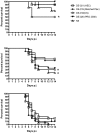Bridging the gap between preclinical and clinical microbicide trials: blind evaluation of candidate gels in murine models of efficacy and safety
- PMID: 22096611
- PMCID: PMC3214080
- DOI: 10.1371/journal.pone.0027675
Bridging the gap between preclinical and clinical microbicide trials: blind evaluation of candidate gels in murine models of efficacy and safety
Abstract
Background: Despite significant protection in preclinical studies, cellulose sulfate (CS) failed to protect women against HIV-1/2 and was associated with a trend toward increased HIV-1 acquisition in one of the clinical trials. These results highlight the need for preclinical tests more predictive of clinical outcomes. The objective of this study was to test coded vaginal gels, including CS, in murine models of safety and efficacy to determine the models' utility for evaluating future products.
Methods: Four coded formulations, including 6% CS, 2% PRO 2000 and two placebo gels, were administered intravaginally to medroxyprogesterone-treated mice and their ability to prevent genital herpes (efficacy) or to alter the susceptibility to low dose HSV challenge (safety) was determined. Nonoyxnol-9 served as a positive toxicity control.
Results: CS and PRO 2000 significantly protected mice from genital herpes following infection with a laboratory or clinical isolate of HSV-2 introduced in buffer (p<0.001). However, protection was reduced when virus was introduced in seminal plasma. Moreover, mice were significantly more susceptible to infection with low doses of HSV-2 when challenged 12 h after the 7th daily dose of CS or nonoxynol-9 (p<0.05). The increased susceptibility was associated with alterations in epithelial architecture.
Conclusions: CS prevented genital herpes when present at the time of viral challenge, but increased the rate of infection when gel was applied daily for 7 days with a vaginal wash prior to viral inoculation. The findings presumably reflect altered epithelial architecture, which may have contributed to the trend towards increased HIV observed clinically.
Conflict of interest statement
Figures





Similar articles
-
Susceptibility to genital herpes as a biomarker predictive of increased HIV risk: expansion of a murine model of microbicide safety.Antivir Ther. 2009;14(8):1113-24. doi: 10.3851/IMP1463. Antivir Ther. 2009. PMID: 20032541 Free PMC article.
-
A comprehensive murine model to evaluate topical vaginal microbicides: mucosal inflammation and susceptibility to genital herpes as surrogate markers of safety.J Infect Dis. 2007 May 1;195(9):1332-9. doi: 10.1086/513279. Epub 2007 Mar 19. J Infect Dis. 2007. PMID: 17397004
-
Prophylactic treatment with a novel bioadhesive gel formulation containing aciclovir and tenofovir protects from HSV-2 infection.J Antimicrob Chemother. 2014 Dec;69(12):3282-93. doi: 10.1093/jac/dku318. Epub 2014 Aug 19. J Antimicrob Chemother. 2014. PMID: 25139839 Free PMC article.
-
Preclinical assessments of vaginal microbicide candidate safety and efficacy.Adv Drug Deliv Rev. 2015 Sep 15;92:27-38. doi: 10.1016/j.addr.2014.12.005. Epub 2014 Dec 24. Adv Drug Deliv Rev. 2015. PMID: 25543007 Review.
-
Clinical development of microbicides for the prevention of HIV infection.Curr Pharm Des. 2004;10(3):315-36. doi: 10.2174/1381612043386374. Curr Pharm Des. 2004. PMID: 14754390 Review.
Cited by
-
Short communication: expression of transporters and metabolizing enzymes in the female lower genital tract: implications for microbicide research.AIDS Res Hum Retroviruses. 2013 Nov;29(11):1496-503. doi: 10.1089/aid.2013.0032. Epub 2013 May 17. AIDS Res Hum Retroviruses. 2013. PMID: 23607746 Free PMC article.
-
A potent combination microbicide that targets SHIV-RT, HSV-2 and HPV.PLoS One. 2014 Apr 16;9(4):e94547. doi: 10.1371/journal.pone.0094547. eCollection 2014. PLoS One. 2014. PMID: 24740100 Free PMC article.
-
Multipurpose prevention technologies: the future of HIV and STI protection.Trends Microbiol. 2015 Jul;23(7):429-436. doi: 10.1016/j.tim.2015.02.006. Epub 2015 Mar 7. Trends Microbiol. 2015. PMID: 25759332 Free PMC article. Review.
-
The Low-Cost Compound Lignosulfonic Acid (LA) Exhibits Broad-Spectrum Anti-HIV and Anti-HSV Activity and Has Potential for Microbicidal Applications.PLoS One. 2015 Jul 1;10(7):e0131219. doi: 10.1371/journal.pone.0131219. eCollection 2015. PLoS One. 2015. PMID: 26132818 Free PMC article.
-
Evaluation of the fusion inhibitor P3 peptide as a potential microbicide to prevent HIV transmission in women.PLoS One. 2018 Apr 18;13(4):e0195744. doi: 10.1371/journal.pone.0195744. eCollection 2018. PLoS One. 2018. PMID: 29668740 Free PMC article.
References
-
- Van Damme L, Govinden R, Mirembe FM, Guedou F, Solomon S, et al. Lack of effectiveness of cellulose sulfate gel for the prevention of vaginal HIV transmission. N Engl J Med. 2008;359:463–472. - PubMed
-
- Van Damme L, Ramjee G, Alary M, Vuylsteke B, Chandeying V, et al. Effectiveness of COL-1492, a nonoxynol-9 vaginal gel, on HIV-1 transmission in female sex workers: a randomised controlled trial. Lancet. 2002;360:971–977. - PubMed
Publication types
MeSH terms
Substances
Grants and funding
LinkOut - more resources
Full Text Sources
Other Literature Sources
Medical
Miscellaneous

